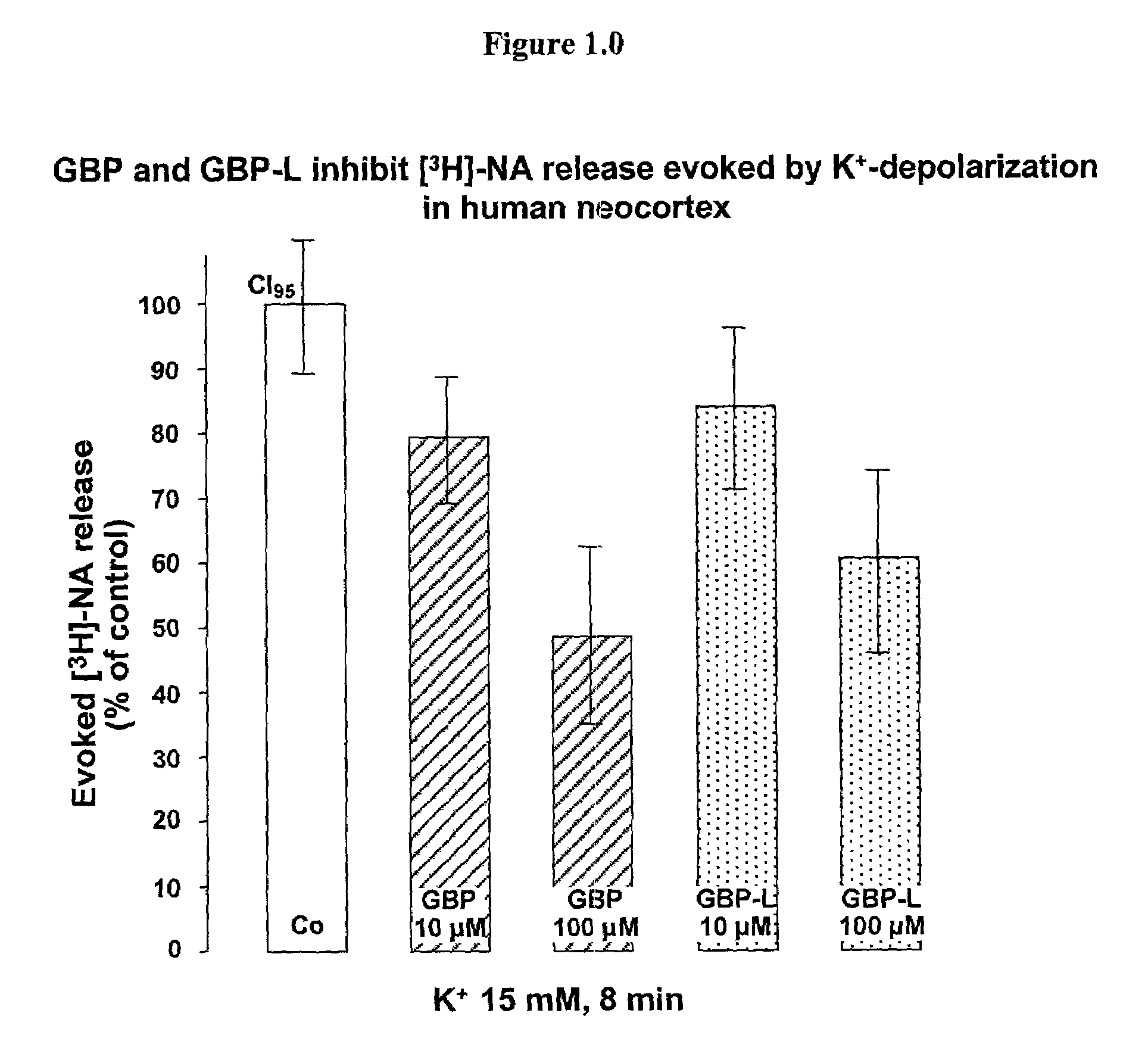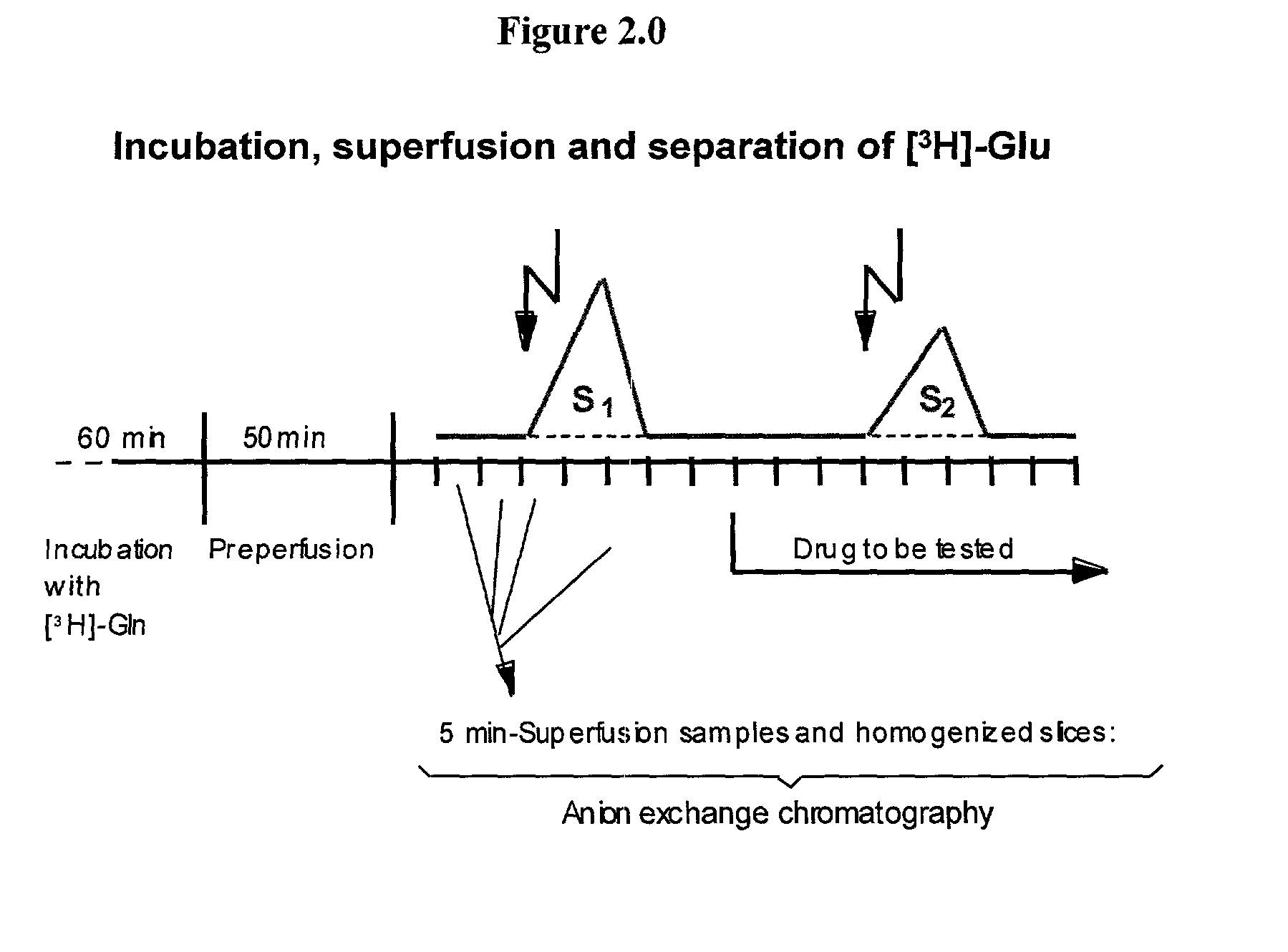2-pyrrolidinone derivatives substituted at position 4 for reducing the extracellular glutamate level
a technology of pyrrolidinone and derivatives, which is applied in the direction of biocide, plant growth regulators, animal husbandry, etc., can solve the problems of limiting the therapeutic use and no satisfactory pharmaceutical which effectively reduces so as to reduce the extracellular glutamate level, influence the glutamatergic transmission, and prevent depolarization and overexcitation
- Summary
- Abstract
- Description
- Claims
- Application Information
AI Technical Summary
Benefits of technology
Problems solved by technology
Method used
Image
Examples
example 1
[0047]A solution of gabapentin (100 μM) in physiological buffer (composition below) with a pH of 7.4 was prepared and irradiated with ultraviolet light (260 and 330 nanometers) at 37° C. for two hours. As described in Kearney A. S. et al., International Journal of Pharmaceutics, 78 (1992), 25–34, this slowly produces the lactam 8-azaspiro[5,4]decan-9-one. Because of the slow reaction rate, a yield of about 1% is assumed in accordance with Kearney et al. (1992), which corresponds to a 1 μM solution.
[0048]The activity of this solution in reducing the extracellular glutamate level was shown by means of superfusion experiments on rat brain slices. Slices with a thickness of 350 μm from the rat striatum were used for this. In each case, two slices were employed in a superfusion chamber with an extremely small dead volume, about 100 μl. Physiological buffer (concentrations in mM: NaCl 121, KCl 1.8, CaCl2, 1.3, MgSO4
1.2, NaHCO3 25, KH2PO3 1.2, glucose 11, pH 7.4, 95% O2 / 5% CO2-saturated) ...
example 2
[0051]The neuroprotective effect of the compounds according to the invention was demonstrated in vivo on the basis of the publication in Invest Ophthalmol Vis Sci 39: 1063–1066, 1998. The following results were found:
[0052]10 rats were treated with 0.9% NaCl i.p. at the start of a unilateral one-hour intraocular pressure increase. After 6 hours, the treatment was again carried out with 0.9% NaCl i.p. After 14 days, the rats were sacrificed, and the retinal gangliocytes were investigated. Compared with the respective control eye, only 17.4% (±4%) of the retinal gangliocytes had survived. The rats behaved completely normally in the 14 days after the test, and no animal died.
[0053]In the test group, likewise of 10 rats, 50 mg / kg 8-azaspiro[5,4]decan-9-one was administered i.p. at the start of a unilateral one-hour intraocular pressure increase. The compound was administered again in a dose of 50 mg / kg 6 hours after the intraocular pressure increase. After 14 days, the rats were sacrifi...
example 3
[0055]It was possible to show in another in vitro test that the antiischemic mechanism of action of the compounds according to the invention is based on a reduction in the released Glu.
[0056]Rat hippocampus slices 350 μm thick were incubated in 3 ml of medium at 37° C. for 60 minutes. The medium contained 2 μM [3H]-Gln to label the endogenous Gln pool. The slices then synthesized Glu. The slices were washed and then exposed to superfusion with a buffer for 50 minutes. At 5-minute intervals, [3H]-Glu was extracted by anion exchange chromatography from a total of 15 superfusion samples and was measured by liquid scintillation counting. The fractional rates of [3H]-Glu release were calculated from the [3H]-Glu extracted from the superfusion samples and from the tissue slices after the superfusion.
[0057]Gabapentin lactam was first investigated in a model in which the release was induced by electrical stimulation. The release in this model responds both to tetrodotoxin and to extracellul...
PUM
| Property | Measurement | Unit |
|---|---|---|
| pH | aaaaa | aaaaa |
| thickness | aaaaa | aaaaa |
| dead volume | aaaaa | aaaaa |
Abstract
Description
Claims
Application Information
 Login to View More
Login to View More - R&D
- Intellectual Property
- Life Sciences
- Materials
- Tech Scout
- Unparalleled Data Quality
- Higher Quality Content
- 60% Fewer Hallucinations
Browse by: Latest US Patents, China's latest patents, Technical Efficacy Thesaurus, Application Domain, Technology Topic, Popular Technical Reports.
© 2025 PatSnap. All rights reserved.Legal|Privacy policy|Modern Slavery Act Transparency Statement|Sitemap|About US| Contact US: help@patsnap.com



